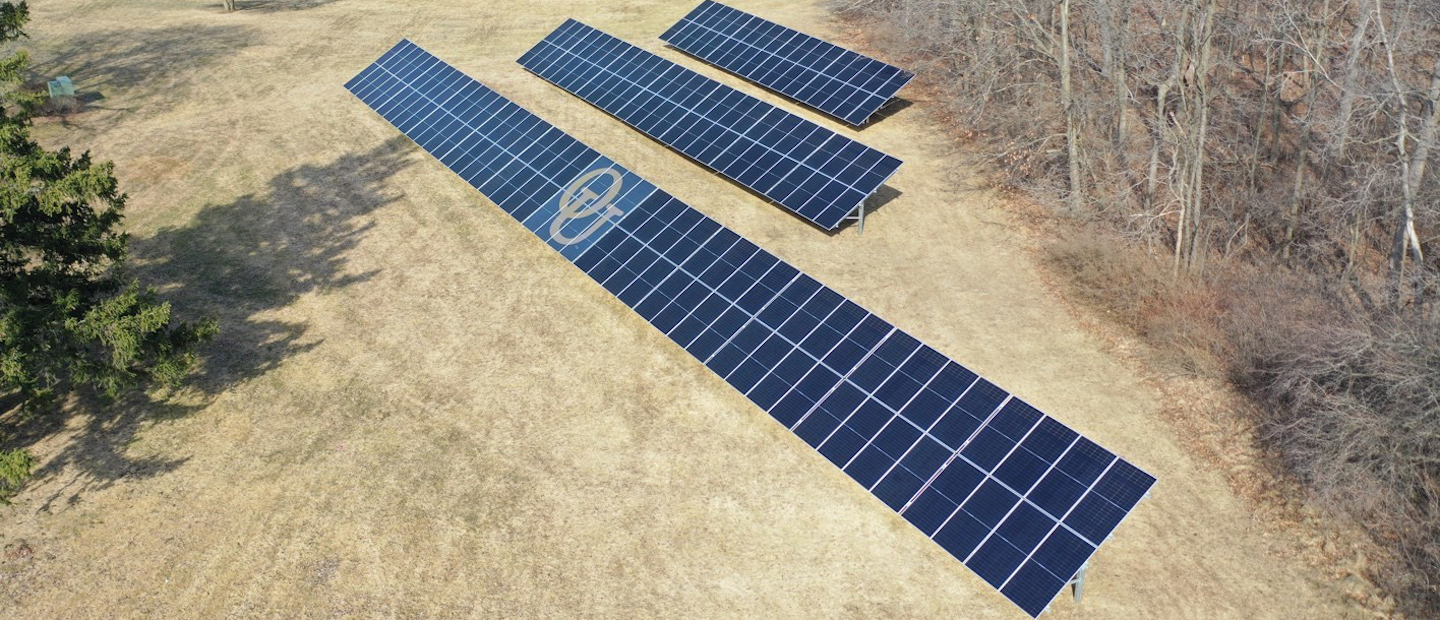
Engineering and Energy
The primary services and responsibilities of the Engineering and Energy department include management and implementation of the university's infrastructure projects, renovation of existing facilities, oversight of the university's master plan and support for construction of new high performance green buildings including the LEED Platinum certified Human Health Building and LEED Gold certified Engineering Center, Hillcrest Hall, and Oak View Hall. In addition, we oversee the university's storm water management program, engineering design documents, purchase of utilities and implementation of a variety of energy initiatives. We also manage the database for the campus' capital assets, continuously promoting initiatives for sustainability best practices and green culture within the campus community.
Rafi Bayrakdarian
Director of Engineering & Energy
(248) 370-4990
[email protected]
TBD
Sr. Engineer
Alex Hatala
Office Assistant II
(248) 370-4434
[email protected]
Jonathan Sterns
AutoCAD/Technical Support
(248) 370-4433
[email protected]
We need your help! A significant amount of electricity is used during the night time and weekend hours. The University maintains at least 2 megawatts of electrical consumption throughout evenings and weekends. Each of the spikes is one day. The spikes are grouped a weekly pattern of five high usage days and two weekend days.
Our summer electrical usage peaked at just over 7.5 Megawatts.
A significant portion of this off-peak usage comes from equipment that is not turned off! Lights, computer monitors, computers, printers, copy machines, etc... should all be turned off during the evening to extend their operating life, save energy, and save on pollution the resulting to our environment.
Oakland University imports 30%-35% of the total campus electricity consumption from DTE. The remaining 65%-70% is produced on-site by a Cogeneration plant.
The Cogeneration plant consists of a Centaur 50 gas turbine rated at 4,600 KW, and a Waste Heat Recovery/Duct Burners unit that converts the recovered waste exhaust into hot water.
The hot water is then sent out to the campus buildings via the hot water piping distribution system.
The High Temperature Hot Water (HTHW) is used for heating, domestic hot water, and cooling with the absorption chillers in the campus buildings.
Utility Consumption and Onsite Production of Electricity and High Temperature Hot Water (FY24 Main Campus Data)
Campus Consumption: 46,867,184 KWH
Onsite Production: 32,176,592 KWH
DTE Purchase: 14,690,592 KWH
Cogeneration Heating Hot Water Production: 338,458 MMBTU
Natural Gas Purchase and Consumption: 583,204 MMBTU
Water and Sewer: 67,930 KGAL
Calculated by Oakland University, Energy Management
Oakland University Facilities Management purchases utilities from Detroit Edison, Consumers Energy, Auburn Hills, Rochester Hills, and other various suppliers. All but a few campus buildings are submetered so that utility usage is now building by building. Where a department occupies only a portion of a building, an estimate is made on a percentage of square footage basis.
Please direct questions to Rafi Bayrakdarian, Director of Engineering & Energy.
A Cogeneration system is also called a Combined Heat and Power; it consists of a turbine generator that burns natural gas which produces electrical power and waste exhaust. The waste exhaust is recovered and converted into hot water.
This system produces electric and thermal energy from a single source of fuel and consumes the natural gas in the turbine to generate electricity and recoverable heat from the exhaust air stream. The exhaust air stream, at approximately 950 degrees F, is ducted into the Waste Heat Recovery Unit (WHRU) to produce high temperature hot water.
The hot water is then sent out to the campus buildings via the hot water piping distribution system. The hot water is used for heating the buildings, for domestic hot water usage, and also for cooling with the absorption chillers.
When the University's heating requirement exceeds the recovered energy from the exhaust, a supplemental duct burner in the WHRU provides additional heating at 90% efficiency.
When the University's heating load is less than the recovered energy from the exhaust, the diverter bypass damper located in the WHRU releases the excess exhaust heat.
Why did Oakland University install Combined Heating and Power (CHP)
- Modernize the energy infrastructure and replace two aging hot water generators.
- Increase University's energy efficiency and power reliability.
- Reduce overall energy costs by up to 33%; $9.87 Million in net savings over the 15-year term of the project.
- Reduce CO2 emissions by 34,854 metric tons annually, the equivalent of preserving 311 acres of mature forest.
The cogeneration project is a major step towards Oakland University's sustainability commitment and goals.
- The project was a Public Private Partnership with no cost to OU.
- The cost of the project is being paid by the energy savings on a 15-year term.
- The total project cost is $12.7 million, and the payback is less than 8 years.
- The system is capable of producing approx. 67% of the campus electrical load and over 95% of the campus heating load.
- The net savings, after paying the financing and the maintenance fees, is $600,000 per year.
January 2012 - Facilities Management team started working internally on the feasibility of a cogeneration project.
April 2013 - The project RFP was issued, and a project developer and construction manager were selected.
October 2013 - The Board of Trustees approved the project.
December 2013 - The Engineering design and project development phase began.
December 2014 - After 3 months of project financing negotiations, the final contract documents were signed.
January 2015 - Construction at the Central Heating Plant began.
July 2016 - The Cogeneration system started producing electric power and hot water.
- Name and Model number of Turbine: Solar Turbine, Centaur 50
- Electrical capacity: 4,600 KW
- Thermal capacity: 60 Million BTUH (with Duct Burners), 25 Million BTUH (without Duct Burners)
- Electricity produced: 30 Million KWH per year
- % of electrical load of campus: 67%
- % of thermal load of campus: >95%
- Thermal Energy produced: 300,000 Million Btu per year
- Payback period: 8 years simple payback
- 25-year cash flow: $24 Million (after 15 years, there are no finance fees)
- 15-year cash flow: $9.0 Million
- Annual Projected Energy savings: $1.6 Million dollar
- Annual Guaranteed Energy Savings: $1.2 Million dollar
- Annual net savings after paying financing cost & other fees: $600,000
- Efficiency: 90% at full capacity
- Project Cost: $12.7 Million
View the CoGen Charts and Tables on the Employee Resource Network.
Sunset Terrace is the first building at Oakland University to be served by 100% renewable green energy. A 100-Kilowatt PV solar system will produce 112,000 kilowatt-hour per year, equivalent to 100% of all electricity to operate the entire house all year round, including heating and cooling through high-efficiency electric heat pumps. In the summer months, when PV production exceeds consumption, the surplus electricity is to be exported to DTE via the electric smart meter.
Oakland University partnered with Michigan Solar Solutions (MSS) to design, engineer, and install a custom ground-mounted solar photovoltaic (PV) system. MSS designed a fixed-tilt, driven-pile ground mount system featuring solar panels assembled in the United States. Engineered to maximize energy production throughout the day, the system aligns with the electricity consumption, enhancing efficiency and cost savings.
The project cost will be $220,000, with an annual energy savings of $16,000. The payback is less than 14 years.
The financial feasibility of this project was partly enabled by the Elective Pay provision under the Section 48E Energy Investment Tax Credit, introduced through the Inflation Reduction Act (IRA) of 2022. This provision allowed tax-exempt institutions like Oakland University to directly benefit from federal clean energy incentives. Oakland University will receive an estimated credit of $95,000.
The clean energy generated will offset and reduce the annual GHG emissions by 80 Metric Tons of Carbon Dioxide (CO2), which is equivalent to greenhouse gas emissions from 20 gasoline-powered vehicles driven for one year, or equivalent to the carbon sequestration of 1,245 tree seedlings grown for 10 years.
Facilities Management
411 Pioneer Drive
Rochester, MI 48309-4482
(location map)
Siraj Khan
Associate Vice President for Facilities Management
Oakland University
Rochester, Michigan 48309-4401
(248) 370-2160







